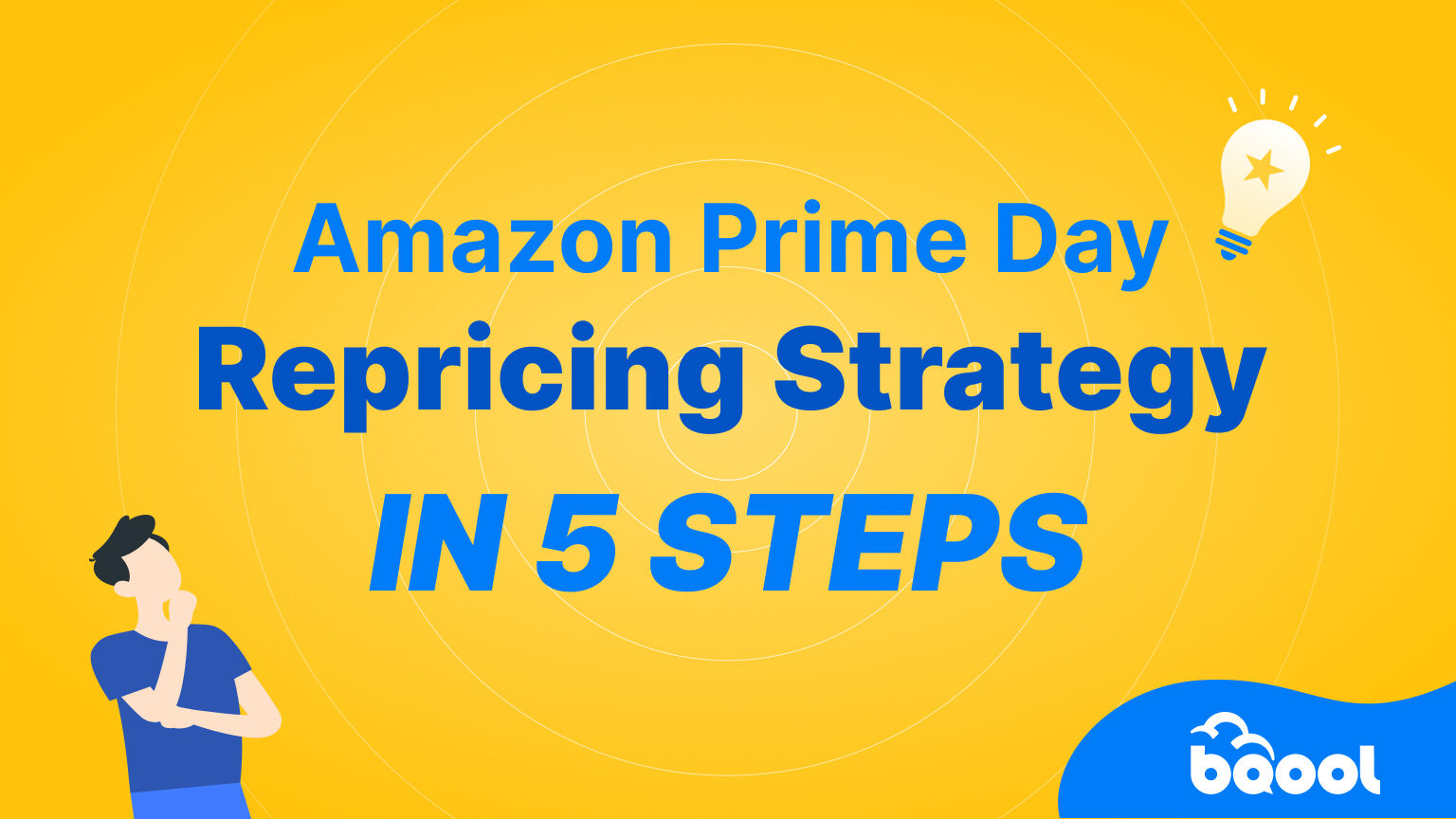Guide to Prime Day Marketing & Advertising 2025

Blog Summary
Start Prime Day ad prep two weeks early, triple your budgets, monitor ROAS alongside ACoS, prioritize top-performing ASINs, defend your brand keywords, and have omnichannel backups ready for maximum sales and profit. Read this guide to Prime Day Marketing & Advertising 2025 to be fully prepared.

Blog Summary
Does Prime Day Still Pay Off in 2025?
Although the exact dates have yet to be announced, Prime Day 2025 is shaping up to be Amazon’s biggest yet, expanding from the traditional two-day event into a four-day shopping extravaganza. Sales are expected to surpass last year’s impressive total of $14.2 billion. Despite a portion of shoppers reportedly going on an “Amazon Diet”, we anticipate significant sales activity and plenty of opportunities for sellers as there are still more than 180 million Amazon shoppers in the U.S. alone. That’s why we prepared this Guide to Prime Day Marketing & Advertising 2025 to help you navigate Prime Day.
Contents
Some Prime Day 2024 Insights
To gear up for Prime Day 2025, start by reviewing last year’s results. Here are the key stats on peak shopping times, top-performing categories, and shopper behavior, insights you can use to fine-tune your 2025 ad strategy.
| Prime Day Insight | What it Means for Sellers |
|---|---|
| 42% of sales came from Computers & Electronics and 21% from Home & Kitchen, making up nearly two-thirds of total revenue. | High-ticket electronics and home products drive the bulk of Prime Day orders—stock up and spotlight these categories in your ads. |
| Shopping surged after 8 PM, peaked around midnight, and remained strong until about 7 AM. | Shift more budget and raise bids for late-night and early-morning campaigns to reach shoppers when they’re most active. |
| Millennials were the biggest Prime Day spenders, followed closely by Gen Z; Boomers shopped the least. | Tailor your creative, especially videos and social ads, to appeal to Millennial and Gen Z audiences for best engagement. |
Source: NielsenIQ, 2024
Your Prime Day Ads Timeline
Preparation is everything. This two-week timeline highlights the key steps like data reviews, campaign scaling, listing updates, and budget adjustments that are needed to prepare and optimize your Prime Day advertising from pre-launch through post-event remarketing.
| When | Task | Why It Matters |
|---|---|---|
| 14 days before | Review last year’s Prime Day data; identify winning keywords | Helps you replicate past success quickly |
| 12 days before | Launch discovery campaigns at slightly lower bids (around 20% less than average) | Efficiently finds profitable keywords without overspending |
| 10 days before | Refresh your ad creative; highlight your Prime Day deals clearly | Makes your deals stand out to early shoppers |
| 7 days before | Increase your advertising budget by 50%; start pushing Sponsored Brand campaigns | Captures buyers starting their research early |
| 2 days before | Triple your usual daily budgets; enable aggressive bid strategies | Ensures continuous visibility during the highest-traffic days |
| Prime Day (Day 1 & Day 2) | Monitor closely, adjusting budgets and bids hourly | Maintains your competitive edge |
| After Prime Day | Reduce bids by around 20% but keep remarketing campaigns running for two weeks | Captures late decision-makers and maximizes return on investment |
Source: Adspert, 2025
How to Pick Prime Day Winning Products
While it might be tempting to use this high-traffic period to clear slow-moving inventory, you’ll likely see better results by focusing on your proven best-seller items with a strong sales history and high ratings.
Historically under-performing products are harder to convert, so it’s better to identify and promote items that have sold well in the last 90 days. Prime Day is the ideal time to boost sales of your highest-performing products.
| Promote These | Pause These |
|---|---|
| Top-selling items (last 90 days) | Poorly reviewed items (under 3.5 stars) |
| Flag ASINs in the top 20 % for sales and ACoS, then rank by ROAS to zero in on the most cost-efficient earners. | Low-margin items |
| Items eligible for Lightning Deals or coupons | Low inventory or slow-moving stock |
How To Check Your Amazon Ads Product Performance
Before you pour extra budget into Prime Day campaigns, you’ll want to zero in on the ASINs that already perform best. Follow these six quick steps in Amazon Seller Central to pull the right reports, sift for top sellers, verify their click and conversion rates, and then bundle them into a “Prime-Day Heroes” portfolio for instant budget and bid boosts when the sale kicks off.
Open Campaign Manager
Seller Central → Advertising → Campaign Manager
Download a 90-day “Performance over time” report
Campaign Manager left menu → Reports centre → Sponsored Products → Performance over time → Create report → Export CSV
Sort for winners
In Excel/Sheets, sort the CSV by Units Ordered, Total Sales, ACoS.
Flag ASINs in roughly the top 20 % for sales that also meet your target ACoS.
Confirm strong CTR and conversion
Reports centre → Sponsored Products → Placement report (listed as “Campaign placements” in some accounts).
Check that the flagged ASINs post above-average CTR and Conversion Rate.
Validate in Business Reports
Seller Central → Reports → Business Reports → Detail Page Sales & Traffic by Child ASIN.
Make sure the same ASINs show strong Sessions and high Unit Session %.
Group your “Prime-Day Heroes” with a Portfolio
Create (or move) campaigns that advertise only these top ASINs, then:
Campaign Manager → select those campaigns → Move to portfolio → create Prime-Day Heroes.
This lets you raise budgets and bids across all winning campaigns in a single action when Prime Day starts.
How To Set Budgets & Bids for Prime Day
Scaling your budgets and bids for Prime Day is all about matching the surge in shopper demand while staying efficient. Plan to invest 2–3x your usual daily budget during the peak event, then dial your bids up or down by match type as you move from discovery to event day and into post-event remarketing. Use the table below for straightforward formulas to guide you through each phase.
| Ad Match Type | Pre-Prime Day (Discovery) | Prime Day Event | Post-Event (Remarketing) |
|---|---|---|---|
| Broad | Base bid × 0.8 | Base bid × 1.3 | Base bid |
| Phrase | Base bid | Base bid × 1.5 | Base bid × 0.9 |
| Exact | Base bid | Base bid × 1.8 | Base bid × 1.1 |
Pro Tip
Keep an eye on your ad budget throughout the day. If a campaign spends 70% of its daily budget by lunchtime, it could stop running during your peak sales hours. You can manually check your spend in Seller Central or use a tool like Amazon Marketing Stream for hourly updates. Also watch your return on ad spend (ROAS). If your ROAS falls below your goal, lowering your bids on keywords that aren’t delivering a good return.
Best Prime Day Amazon Ad Types
To maximize sales during Prime Day, implement a full-funnel advertising strategy that engages customers at every stage of their journey. Use these ad types:
| Ad Type | Placement | Purpose | Best For |
|---|---|---|---|
| Sponsored Products | Search results, product detail pages | Drive conversions | High-intent shoppers |
| Sponsored Brands | Top of search results | Increase brand visibility | Showcasing multiple products |
| Sponsored Display | Product pages, off-Amazon sites | Retargeting | Re-engaging past visitors |
| Amazon DSP | Various websites and apps | Audience targeting | Programmatic advertising |
Source: skai.io, 2024
Top-of-Funnel: Build Brand Awareness
- Sponsored Display Ads
Reach potential customers both on and off Amazon through Sponsored Display ads. These ads appear on product detail pages, customer reviews, shopping results, and third-party websites and apps, making them ideal for introducing your brand to new audiences. - Video and Audio Ads
Utilize Video and Audio Ads to capture attention across platforms like Amazon Music, Alexa News, and Amazon-owned websites. These formats are effective for building brand awareness and engaging users who may not be actively shopping but are receptive to discovering new products.
Mid-Funnel: Foster Consideration
- Sponsored Brands Ads
Showcase a selection of your products along with your brand logo and a custom headline. These ads appear in prominent placements within shopping results, helping to drive traffic to your Brand Store or a custom landing page, thereby enhancing brand visibility and encouraging product exploration. - Amazon Posts and Amazon Live
Engage customers with Amazon Posts, which function similarly to social media posts, offering compelling imagery and copy to tell your brand story. Additionally, Amazon Live allows for real-time interaction with shoppers through live-streamed product demonstrations and Q&A sessions, building trust and interest.
Bottom-of-Funnel: Drive Conversions
- Sponsored Products Ads
Target high-intent shoppers by placing your products in search results and on product detail pages. These ads are crucial for capturing customers ready to make a purchase, especially during the high-traffic Prime Day event. - Amazon DSP (Demand-Side Platform)
Leverage Amazon DSP to retarget shoppers who have viewed your products but haven’t purchased. This platform allows for advanced audience targeting based on shopping behavior, interests, and demographics, helping to re-engage potential buyers and drive conversions.
Stay profitable this Prime Day with BQool’s AI Repricer
Begin trial
Listing Tips for Higher Conversions
Now that you’ve chosen the right ad formats, the next step is sharpening your listings to turn impressions into clicks and sales. Focus on clear deal messaging, urgency, and consistent visuals to help shoppers convert throughout Prime Day. Here are a few quick tips:
- Clearly label your deals: Include “Prime Day Deal” or equivalent value messaging in your ad copy, within Amazon’s guidelines.
- Clear and concise messages that highlight urgency: Countdown timers, “Limited Time,” and deal expiration language can drive higher click and conversion rates these tactics can boost CTR by 15–20% during Prime Day.
- Maintain visual consistency: Ensure that your Prime Day messaging is aligned across your ads, Brand Store, and product detail pages to reinforce trust and reduce drop-off.
Defend Your Brand & Storefront
Competitors will aggressively bid on your branded terms during Prime Day. Counter this effectively by:
- Bidding defensively on your brand keywords with exact-match campaigns.
- Directing traffic to your branded Prime Day landing page on your Storefront.
- Using clear headlines like “Official Brand Deals” to discourage shoppers from clicking competitor ads.
Prime Day 2025: Hourly Shopper Trends
Prime Day ad performance can differ depending on the time of day. Use the hourly guide below:
| Time (PDT) | Metric to Monitor | Recommended Action | Rationale |
|---|---|---|---|
| 12:00 AM – 8:00 AM | Budget Utilization | If spend exceeds 60% of your daily budget early, consider increasing the budget or redistributing it to high-performing campaigns. | Early high spend may indicate strong overnight traffic; adjusting budgets ensures ads remain active during peak hours. |
| 8:00 AM – 4:00 PM | Click-Through Rate (CTR) & Conversion Rate (CVR) | If CTR or CVR declines, review ad creatives and targeting; consider increasing bids for high-performing keywords. | Midday hours often see increased competition; optimizing bids and creatives can maintain ad performance. |
| 4:00 PM – 12:00 AM | Advertising Cost of Sales (ACoS) | If ACoS exceeds your target by more than 20%, reduce bids by 10–15% or pause underperforming keywords. | Evening hours may lead to higher ACoS due to increased browsing; adjusting bids helps control costs. |
Pro Tips
- Use Amazon’s “Adjust Bids by Placement” Feature and increase bids for top-performing placements, such as “Top of Search,” to enhance visibility where conversion rates are higher.
- Consider using “Dynamic Bids – Up and Down” to allow Amazon to adjust your bids in real-time based on the likelihood of conversion.
- Continuously monitor campaign performance metrics to make timely adjustments, ensuring optimal ad spend efficiency.
Your Prime Day Ads Checklist
As you wrap up your Prime Day planning, keep these five practical steps in mind to sustain performance during the event and carry momentum into the weeks that follow:
-
Start two weeks early with the right budget.
Activate campaigns 14 days before Prime Day and allocate 2–3× your normal daily spend during the four-day event. Include bids on your own brand terms to maintain control of your traffic. -
Promote only your strongest ASINs.
Prioritize products with consistent sales and 4-star-plus ratings. Avoid low-velocity or poorly reviewed items to ensure your ad dollars drive real results. -
Set up off-Amazon backups.
Prepare email, SMS, and social-media messages so you can quickly redirect customers to your Storefront or website if any listings are paused or restricted. -
Keep ads running after Prime Day.
Reduce bids by about 20% but continue remarketing for at least two weeks to capture late purchasers and encourage reviews. -
Replenish inventory and review your data.
Restock top sellers promptly, then dive into your search-term and placement reports while insights are new and use what you learned to refine next year’s strategy. - Review your ROAS. Compare before, during, and after-event ROAS to see which campaigns delivered the best returns.








